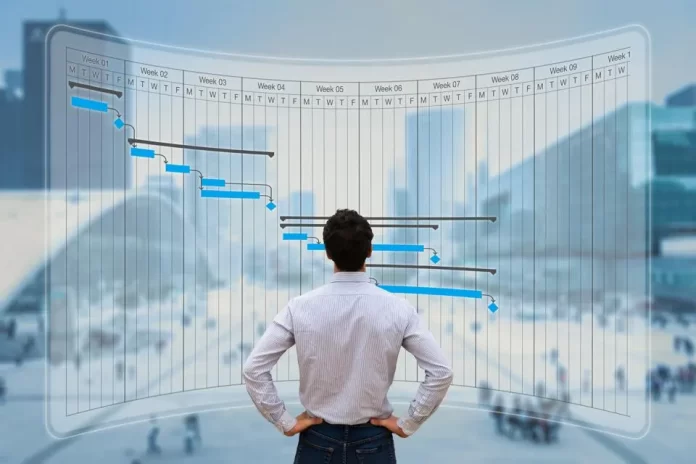Are you tired of the chaos that often accompanies construction projects? Do you wish there was an easier way to manage the complexities of the construction process? Look no further, because project management can be made easy with the right strategies and tools.
By streamlining the construction process, you can ensure that your projects are completed on time, within budget, and to the satisfaction of all stakeholders.
In this article, you will learn about the key components of successful project management, including project planning, resource allocation, risk management, communication, collaboration, and the latest tools and technologies.
By implementing these best practices, you can take your construction projects to the next level and achieve greater success.
Contents
Project Planning for Success
Planning for success in a construction project requires not only identifying goals and objectives but also considering potential obstacles and risks.
Begin by defining your project goals and objectives, including the scope of work, timeline, budget, and resources needed. These objectives should be specific, measurable, achievable, relevant, and time-bound.
Next, identify and analyze potential risks and obstacles that may arise during the project. These may include unexpected delays, changes in regulations or codes, labor shortages, or weather-related issues.

Develop a contingency plan for each potential risk to minimize the impact on the project schedule, budget, and quality. By taking the time to plan for potential challenges, you can increase the likelihood of project success and minimize any negative impact on your team or stakeholders.
Effective Resource Allocation
Proper resource allocation can make or break a project’s success, so it’s crucial to prioritize and distribute resources effectively.
One key aspect of effective resource allocation is understanding the needs and requirements of each project stage. For example, during the planning phase, you may need to allocate more resources to research and design, while during the construction phase, you may need more resources for labor and materials.
It’s important to consider the skills and strengths of your team members when allocating resources. Assign tasks based on each team member’s expertise and experience, and consider cross-training or outsourcing for tasks that require specialized skills.
By allocating resources in a way that maximizes efficiency and utilizes team members’ strengths, you can ensure that your project runs smoothly and meets its goals.
Risk Management Strategies
When it comes to minimizing potential issues and setbacks, you’ll want to focus on identifying and addressing potential risks before they become major obstacles to achieving your goals. This is where risk management strategies come in.
By proactively identifying potential risks, you can take steps to mitigate or eliminate them before they cause delays, budget overruns, or other problems. One effective risk management strategy is to involve all stakeholders in the planning process.
By bringing together representatives from different departments or teams, you can identify potential risks from multiple perspectives and develop comprehensive solutions. Additionally, it’s important to regularly review your risk management plan and update it as necessary.
As your project progresses, new risks may emerge or existing risks may become more pressing, so it’s important to stay vigilant and adaptable. By implementing these strategies, you can reduce the likelihood of major setbacks and keep your project on track.
Communication and Collaboration Best Practices
Effective communication and collaboration are crucial for ensuring the success of any construction project. As a project manager, it’s your responsibility to foster an environment that encourages open and honest communication among team members.
This means establishing clear lines of communication, setting expectations for how information should be shared, and providing the necessary tools and resources to facilitate collaboration. By doing so, you can ensure that everyone is working towards the same goal, and that any issues or concerns are addressed in a timely and efficient manner.
One of the best ways to promote communication and collaboration is to hold regular team meetings. These meetings provide an opportunity for everyone to come together, share updates on their progress, and discuss any challenges they may be facing. Additionally, they allow team members to provide feedback and offer suggestions for improving the project.
When conducting these meetings, it’s important to set an agenda and stick to it, so that everyone stays on track and the meeting remains productive. By prioritizing communication and collaboration, you can streamline the construction process and help ensure a successful outcome for your project.
Tools and Technologies for Streamlining Construction Projects
Using the latest tools and technologies can help construction teams work more efficiently, allowing them to complete projects faster and with fewer errors.
One such tool is Building Information Modeling (BIM), which provides a digital representation of a building’s physical and functional characteristics. This allows for better collaboration and communication between architects, engineers, contractors, and owners throughout the entire construction process.
Another technology that can streamline construction projects is cloud-based project management software. This allows team members to access project information from anywhere, at any time, and on any device. It also allows for real-time updates and collaboration, reducing the need for lengthy email chains and phone calls.
By implementing these tools and technologies, construction teams can save time and money, while also improving the overall quality of their projects.
Conclusion
Now that you’ve learned about the key factors that can streamline your construction project management, it’s time to put them into practice.
Remember to plan meticulously, allocate resources effectively, and manage risks proactively to ensure a successful project outcome.
It’s also important to communicate and collaborate regularly with your team and stakeholders, leveraging the latest tools and technologies to streamline your workflow and optimize your project’s efficiency.
With these best practices in mind, you can confidently tackle complex construction projects, meet tight deadlines, and deliver high-quality results that exceed your clients’ expectations.
So why wait? Start implementing these strategies today and take your project management skills to the next level!



